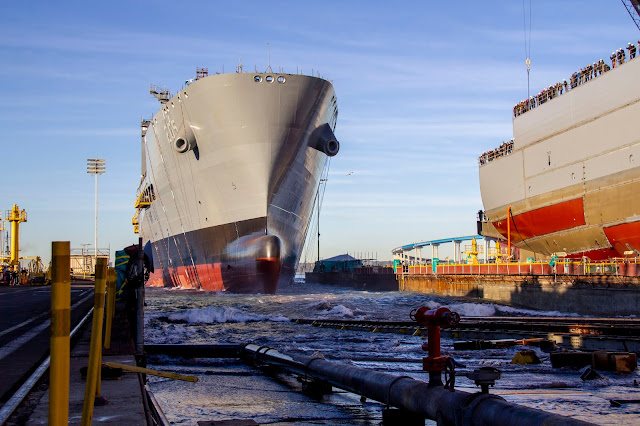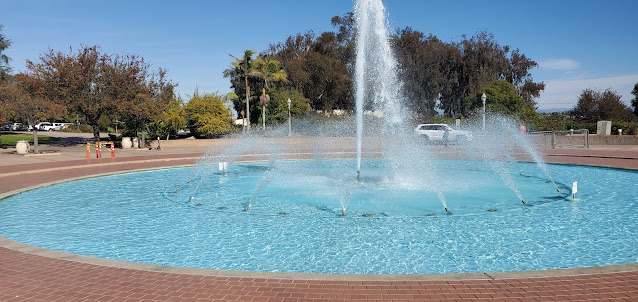Week 2: Launch of the USNS John Lewis, Balboa Park, Pacific Beach
Monday, January 11-Sunday, January 17
We can confidently state that none of us expected to pull our first all-nighter of 2021 so early into the New Year, but alas, Winter Work works in mysterious ways.
On Monday, we arrived at the office at 06:30 and spent the morning setting up our Zoom accounts and filling out some last-minute orientation paperwork. Ioana had the especially delightful experience of battling with her computer log-in which refused to cooperate at any cost.
Around 09:30, we headed back to our Airbnb, where we attempted to catch a few more hours of sleep before heading back to the shipyard at 16:00. Launching a ship is an incredible experience which requires intense labor and coordination from all its participants. Various departments within the shipyard and Mission Valley office, as well as NAVSEA representatives collaborated in order to ensure the safe and successful launch of the USNS John Lewis (T-AO 205), the first of the six fleet oiler vessels awarded to NASSCO for construction.
The primary purpose of the Navy fleet oilers is to extend the operating endurance of Navy ships by supplying them with fuel and cargo. The current existing force of fleet oilers consists of fifteen Henry J. Kaiser class ships. These oilers entered service between 1986 and 1996 and have an expected service life of 35 years. As the first of the new generation of fleet oilers, he USNS John Lewis is a 742-foot long vessel with the capacity of carrying 157,000 barrels of oil. In addition, it features a significant dry cargo capacity (417m^2) and can travel at a speed of 20 knots. For more information, please see the fact sheet (below). You can also review this Congressional report which provides some interesting background and insight into the Navy John Lewis (T-AO 205) Class Oiler Shipbuilding Program or this post by General Dynamics NASSCO on its launch.
A multitude of ship launching methods exist--the most common of which is the side oiled slideway launching. Below, we have included a brief YouTube video which outlines the different types of launching forms.
NASSCO utilizes the longitudinal oiled slideway launching method which employs gravity to slide the ship along a slideway and into the water. This is one of the oldest methods of launching. In the pictures below you can see the slideway as well as the support system constructed for the ship. The support system is made up of steel beams and wooden blocks. Our task throughout the duration of the launch was to take hourly measurements of the strain and creep experienced by the wooden blocks which increased as the scaffolding and supports were removed. When we were not taking measurements, we spent time in the bunker, socializing with the launch crew and regaining our energy by eating the delicious food that our coworkers provided.
The ship launched around 08:00. By that time, each of us had found a spot along the pier from which to view the launch. A video and photos of the ship launch provided by NASSCO is found below.
The Future USNS John Lewis (T-AO 205) Launch from General Dynamics NASSCO on Vimeo.
After finishing up a few last-minute errands, we returned to our Airbnb around 09:00. Following a seventeen-hour-long workday Dillon was ready for some much needed beauty sleep. The more experienced late night crew, Daniel and Ioana, decided to preserve their sleep schedule and take advantage of the warm California weather by taking a trip to downtown San Diego and picking up brunch from Eggies. After a scenic walk through Balboa Park, Daniel and Ioana returned home where they finished and posted last week's blog post before passing out, 37 hours after initially waking up.
The remainder of the week passed in a blur. We started our first tasks at the office which included a research project on heat tracing software for Daniel, open-water bare hull resistance calculations for Ioana, and some light proof-reading for Dillon--which is fitting as he has the most opportunity for improvement in his use of the English language.
We finished the week by having some homemade pizza with our coworkers, including alumni Isa Hill '20, Chris Bal '20, and Nick Ratinaud '18. On Saturday, we celebrated the 80 degree high by going to Pacific Beach and looking forward to the week ahead.


















Comments
Post a Comment